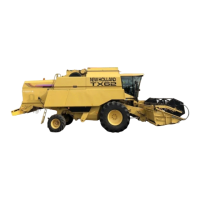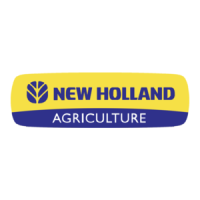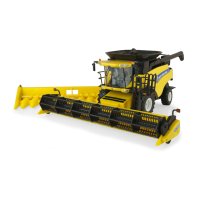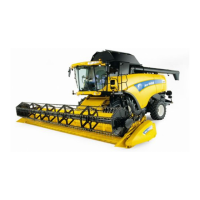Do you have a question about the New Holland TX65 Plus and is the answer not in the manual?
Explanation of safety symbols (CAUTION, WARNING, DANGER) and machine safety statements.
Pre-drive checks including manual, chains, belts, pressures, and torque.
Step-by-step procedure for safely starting the engine, including daily start-up checks.
Importance of regular lubrication for preventing delays and increasing machine life.
Procedure for greasing fittings and lubrication intervals for various components.
Oil level, oil change, and gearbox capacity for traction gearbox.
Engine oil and filter change intervals based on fuel sulphur content.
General information and warnings about combine operation, including safety guards.
Performing header height control calibrations and selecting operating modes.
Using compensation mode for peas and laid crops, adjusting header pressure.
Operating header at preselected stubble height and adjusting it.
Following field contours with autofloat sensors, adjusting stubble height.
Purpose and types of header height control calibrations.
Identifying error reports via blinking sequences of the red autodiagnostic light.
System to reverse header, auger, and elevator to clear blockages.
Synchronizing reel speed to ground speed using switch 43.
Adjusting straw elevator bottom shaft spring tension.
Parameters for selecting drum speed and concave clearance.
Adjusting cleaning fan speed and checking air volume.
Overview of the returns system and consequences of excessive returns.
Cleaning procedures for grain tank components.
Engine shut-off conditions for safety and damage prevention.
Monitoring the combine via InfoView monitor and indicators.
Overview of the InfoView monitor panel layout and buttons.
Different operating modes of the combine: RPM and Area Counter.
Accessing service mode for intervals and error overview.
Table listing error codes, descriptions, and importance.
Purpose and procedure for various system calibrations.
Daily check of belt and chain tensions and maintenance schedule overview.
Checking and adjusting the drum variator drive belt.
Checking and adjusting the torque-sensing drum variator belt.
Checking and adjusting the cleaning fan vari-drive belt.
Procedure for changing variator sheaves and belt.
Procedure for adjusting the roto-thresher concave.
Adjustment procedures for parking brake on different models.
Toe-in adjustment and steering wheel stop settings.
Adjustment procedure for the adjustable steering axle.
Hydraulic hose replacement and safety requirements.
Battery maintenance, charging, and safety tips.
Schedule for service tasks before first start-off and during run-in period.
Concerns related to irregular feeding and material backfeed.
Concerns related to grain not properly threshed and material wrapping.
Causes and corrections for drum blockage.
Causes and corrections for improper grain cleaning.
Causes and corrections for grain loss over sieves.
Troubleshooting for engine starting, power, and overheating issues.
Troubleshooting for chopper vibration, chop quality, and engagement.
Troubleshooting for sluggish performance, system not functioning, or hazardous operation.
Troubleshooting for reel and unloading tube control issues.
Troubleshooting for header, threshing, unloading, lateral float, and reversing controls.
Manual procedure for selecting gears when electrical selection fails.
Manual procedure for releasing the parking brake.
Procedure for driving the combine after manual reset of gears and brake.
Steps for preparing the combine for storage to ensure good condition.
Steps to ensure the machine is in good condition and ready for use at the start of the season.
Location of fire extinguisher within operator's reach.
Explanation of safety symbols (CAUTION, WARNING, DANGER) and machine safety statements.
Pre-drive checks including manual, chains, belts, pressures, and torque.
Step-by-step procedure for safely starting the engine, including daily start-up checks.
Importance of regular lubrication for preventing delays and increasing machine life.
Procedure for greasing fittings and lubrication intervals for various components.
Oil level, oil change, and gearbox capacity for traction gearbox.
Engine oil and filter change intervals based on fuel sulphur content.
General information and warnings about combine operation, including safety guards.
Performing header height control calibrations and selecting operating modes.
Using compensation mode for peas and laid crops, adjusting header pressure.
Operating header at preselected stubble height and adjusting it.
Following field contours with autofloat sensors, adjusting stubble height.
Purpose and types of header height control calibrations.
Identifying error reports via blinking sequences of the red autodiagnostic light.
System to reverse header, auger, and elevator to clear blockages.
Synchronizing reel speed to ground speed using switch 43.
Adjusting straw elevator bottom shaft spring tension.
Parameters for selecting drum speed and concave clearance.
Adjusting cleaning fan speed and checking air volume.
Overview of the returns system and consequences of excessive returns.
Cleaning procedures for grain tank components.
Engine shut-off conditions for safety and damage prevention.
Monitoring the combine via InfoView monitor and indicators.
Overview of the InfoView monitor panel layout and buttons.
Different operating modes of the combine: RPM and Area Counter.
Accessing service mode for intervals and error overview.
Table listing error codes, descriptions, and importance.
Purpose and procedure for various system calibrations.
Daily check of belt and chain tensions and maintenance schedule overview.
Checking and adjusting the drum variator drive belt.
Checking and adjusting the torque-sensing drum variator belt.
Checking and adjusting the cleaning fan vari-drive belt.
Procedure for changing variator sheaves and belt.
Procedure for adjusting the roto-thresher concave.
Adjustment procedures for parking brake on different models.
Toe-in adjustment and steering wheel stop settings.
Adjustment procedure for the adjustable steering axle.
Hydraulic hose replacement and safety requirements.
Battery maintenance, charging, and safety tips.
Schedule for service tasks before first start-off and during run-in period.
Concerns related to irregular feeding and material backfeed.
Concerns related to grain not properly threshed and material wrapping.
Causes and corrections for drum blockage.
Causes and corrections for improper grain cleaning.
Causes and corrections for grain loss over sieves.
Troubleshooting for engine starting, power, and overheating issues.
Troubleshooting for chopper vibration, chop quality, and engagement.
Troubleshooting for sluggish performance, system not functioning, or hazardous operation.
Troubleshooting for reel and unloading tube control issues.
Troubleshooting for header, threshing, unloading, lateral float, and reversing controls.
Manual procedure for selecting gears when electrical selection fails.
Manual procedure for releasing the parking brake.
Procedure for driving the combine after manual reset of gears and brake.
Steps for preparing the combine for storage to ensure good condition.
Steps to ensure the machine is in good condition and ready for use at the start of the season.
Location of fire extinguisher within operator's reach.
| Brand | New Holland |
|---|---|
| Model | TX65 Plus |
| Category | Farm Equipment |
| Language | English |











